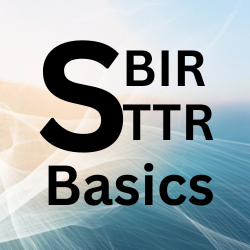The Small Business Innovation Research (SBIR) and Small Business Technology Transfer (STTR) programs provide invaluable funding for small businesses engaged in research and development (R&D). These programs drive innovation by offering critical financial support, particularly for early-stage projects. However, recipients must understand the “costs” of accepting SBIR and STTR funds.
This article breaks down the various “costs” associated with receiving SBIR and STTR funds, from compliance requirements and financial reporting to long-term implications for business strategy and intellectual property (IP) management. Let’s explore what these costs mean for small businesses navigating federal grants.
The Compliance “Cost”: Adhering to Regulations and Reporting Requirements
A significant cost of receiving SBIR or STTR funds is the compliance burden. The federal government imposes strict regulations to ensure proper use of taxpayer dollars. These rules maintain transparency and accountability but can be time-consuming and complex.
Financial Reporting Requirements
SBIR and STTR recipients must submit regular financial reports. These reports document how funds are spent and align with the Project’s objectives. These reports may detail personnel, materials, travel, and equipment costs depending on the award stage. Businesses may need extra administrative support or external accounting help to manage this level of reporting.
Progress and Technical Reporting
Businesses must also submit technical reports to track the Project’s progress. These reports show if the research is on schedule and meeting milestones. Regular submissions require internal resources, and missing deadlines or inaccuracies can result in penalties, reduced funding, or award termination.
Audit Readiness
SBIR and STTR funds are taxpayer dollars and subject to audits. Audits can occur randomly or if discrepancies arise. Businesses must maintain accurate records and follow financial protocols to demonstrate proper fund usage. Setting up a robust financial management system early will make this process easier.
Preparation Tip: Set up strong financial systems from the start and designate a team member (or hire external expertise) to handle compliance and reporting.
The Opportunity “Cost”: Allocating Resources to the Project
SBIR and STTR funds support specific research efforts but come with an opportunity cost. Time and resources invested in meeting grant requirements may divert focus from other business opportunities.
Diversion of Focus and Resources
Small businesses often have limited resources. When receiving an SBIR or STTR award, the company must focus effort and funds on the funded research project. This focus can delay or reduce the ability to pursue other opportunities like marketing, sales, or new growth avenues.
Long-Term Commitment of Time
SBIR and STTR projects typically require multiple phases, each demanding significant time. The business may have to delay other initiatives, like expanding its product line or seeking new customers. These projects also need specialized staff or contractors, which strains resources.
Internal Costs of Project Execution
Although SBIR and STTR funds cover many project-related expenses, they don’t cover everything. Businesses may need to hire extra staff, buy specialized equipment, or pay for indirect costs. These expenses can strain cash flow.
Preparation Tip: Before applying for SBIR or STTR funding, assess your business’s resource needs and create a strategy for balancing the research project with ongoing priorities.
The Administrative “Cost”: Managing Paperwork and Reporting
Managing SBIR and STTR funds involves significant administrative work. The paperwork and reporting requirements can be daunting, especially for small businesses without internal infrastructure.
Time-Consuming Documentation
Businesses must create and submit extensive documentation, from application submissions to progress and final reports. Many small startups may not have the infrastructure to handle this workload, leading to additional administrative costs.
Cost of Compliance Officers or Consultants
Small businesses often hire compliance officers or external consultants to manage the administrative burden. These professionals help companies to stay on track with reporting and documentation but add to the financial burden.
Preparation Tip: Weigh the costs of hiring additional staff against the benefits of securing funding. Consider using software to streamline reporting and documentation.
The Risk “Cost”: Potential Consequences of Non-Compliance
Non-compliance risk is a significant “cost” of receiving SBIR or STTR funds. The government imposes strict rules on using funds, and failing to follow them can result in severe consequences.
Financial Penalties and Repayment Obligations
If a business misuses grant funds, it may have to repay them. Misuse could involve paying unapproved or unallowable expenses. Non-compliance may also affect future funding opportunities.
Damage to Reputation
Non-compliance or misuse of funds can harm a business’s reputation. This damage can affect relationships with funding agencies and impact the company’s credibility with investors, partners, and customers.
Preparation Tip: Establish a clear compliance framework and train employees on SBIR and STTR rules. Conduct internal audits to catch issues early and reduce non-compliance risk.
Conclusion: The Costs of SBIR and STTR Funds Go Beyond Financials
SBIR and STTR programs provide essential funding for innovation. However, accepting these funds involves more than just a financial commitment. Businesses must consider the full range of “costs”—compliance, opportunity costs, administrative burdens, and risks of non-compliance.
By understanding these costs and planning accordingly, small businesses can maximize the benefits of their SBIR and STTR awards while minimizing challenges. Careful management of financial and administrative aspects ensures the company stays on track to meet research goals, comply with regulations, and achieve long-term success.
Preparation Tip: Successfully navigating SBIR and STTR funding requires strategic planning, budgeting, and regulatory compliance. Set clear expectations from the start and prepare for direct and indirect costs.
References:
- S. Small Business Administration. (2020). Small Business Innovation Research (SBIR) Program. Retrieved from https://www.sba.gov/funding-programs
- S. Small Business Administration. (2020). Small Business Technology Transfer (STTR) Program. Retrieved from https://www.sba.gov/funding-programs
- National Institutes of Health. (2020). SBIR/STTR: Policies & Guidelines. Retrieved from https://www.nih.gov/grants-funding
- S. Department of Energy. (2019). SBIR and STTR: Financial Reporting Requirements. Retrieved from https://www.energy.gov
- National Science Foundation. (2020). NSF SBIR/STTR Proposal & Award Policies & Procedures Guide. Retrieved from https://www.nsf.gov
- S. Government Accountability Office. (2018). SBIR and STTR Programs: Federal Agencies Face Challenges in Ensuring Proper Use of Funds. Retrieved from https://www.gao.gov
- S. Department of Defense. (2021). SBIR/STTR Funding Opportunities and Compliance Requirements. Retrieved from https://www.defense.gov
- Small Business Administration. (2019). Guidance for Small Businesses on Managing SBIR and STTR Grants. Retrieved from https://www.sba.gov/management-guides
- S. General Services Administration. (2020). Understanding Audit Readiness for SBIR and STTR Grants. Retrieved from https://www.gsa.gov
- Internal Revenue Service. (2020). IRS Guidance on Tax Implications for SBIR and STTR Grants. Retrieved from https://www.irs.gov

